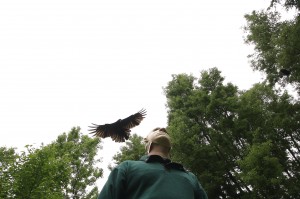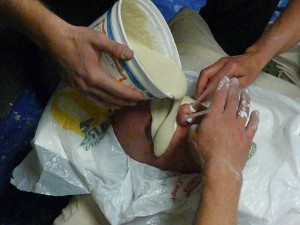
Like Ann, I’m a recent convert to the charm of crows. This has led to a running joke with my husband’s cousin, Roger. At family reunions, I tell him how much I like crows. He tells me how much he likes to shoot them.
Hilarious, right? Here’s the satisfying part: Crows remember Roger. They don’t just remember Roger’s suburban Seattle home and his BB gun. They also seem to remember his face. When he leaves his house, the crows mob him, diving and screeching around his head. (They leave other family members alone.) When this harassment — or retaliation — began, Roger took his campaign into a second-floor bedroom, where he crouched below a windowsill and poked his BB gun through a slit in the screen. But the crows have never forgotten his mug. Years after his last open attack on the noisy neighborhood flocks, he’s still Corvid Enemy Number One.
Now, I have some actual science to bring to our argument. In a paper released today in the Proceedings of the Royal Society B, ecologist John Marzluff and two of his students report that crows are past masters at holding a grudge.
Over the years, I’ve had several chances to write about Marzluff, a corvid researcher who works at the University of Washington — coincidentally or not, quite close to Roger’s neighborhood. I’ve followed Marzluff as he’s tried — with mixed success — to trap crafty crows in the suburbs, and I’ve reported on his and his colleagues’ efforts to turn urban Seattle into an ecological laboratory. Most recently, I wrote about his study of crows’ ability to recognize individual human faces:
To test the birds’ recognition of faces separately from that of clothing, gait and other individual human characteristics, Dr. Marzluff and two students wore rubber masks. He designated a caveman mask as “dangerous” and, in a deliberate gesture of civic generosity, a Dick Cheney mask as “neutral.” Researchers in the dangerous mask then trapped and banded seven crows on the university’s campus in Seattle. In the months that followed, the researchers and volunteers donned the masks on campus, this time walking prescribed routes and not bothering crows.
The crows had not forgotten. They scolded people in the dangerous mask significantly more than they did before they were trapped, even when the mask was disguised with a hat or worn upside down. The neutral mask provoked little reaction. The effect has not only persisted, but also multiplied over the past two years.
In today’s paper, Marzluff and his coauthors report that crows have an even longer memory for human faces than first thought: Crows have now mobbed the dangerous mask for a full five years, and scientists have observed the effect as far as 1.2 kilometers from the original campus study site. Apparently, the original seven crows have taught both their peers and their offspring to carry on their vendetta.
So crows can differentiate between Cheney and a caveman. So what? The researchers speculate that the ability to recognize and remember individual human faces may help crows survive in an increasingly human-dominated world.
The behavior of individual people towards animals is often changing, and recent studies have demonstrated that an ability to discern differences between humans may enable successful species to adapt to, and even coevolve with, human behavior.
Want to survive in the city? Know your enemies.

Whether or not a capacity for personal grudges has contributed to their survival, crows are thriving in Seattle. Thanks in part to expanding suburbs — and their delectable garbage — the local crow population has grown exponentially in recent decades, and suburbanites have become all too familiar with the birds’ raucous chorus.
Sorry, Roger. There goes the neighborhood. But take heart: Cheney masks are still in stock.
Excellent, so if you and many others in the US don a trump mask, and start being mean to crows, then they will mob him and his supporters wherever they go? Now there’s an idea…
Great article. Shortly after we bought our house, we tried to rescue a fledgling crow that had fallen into a basement window well. The parents were not having it. Geoff was wearing a red cap when he tried to move the young bird and was harassed for several years thereafter by its relatives every time he left the house. More so if he wore the cap, but even without it. Fascinating.